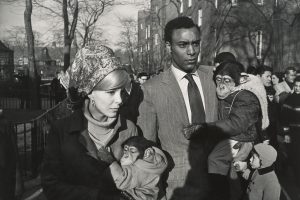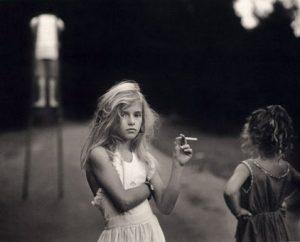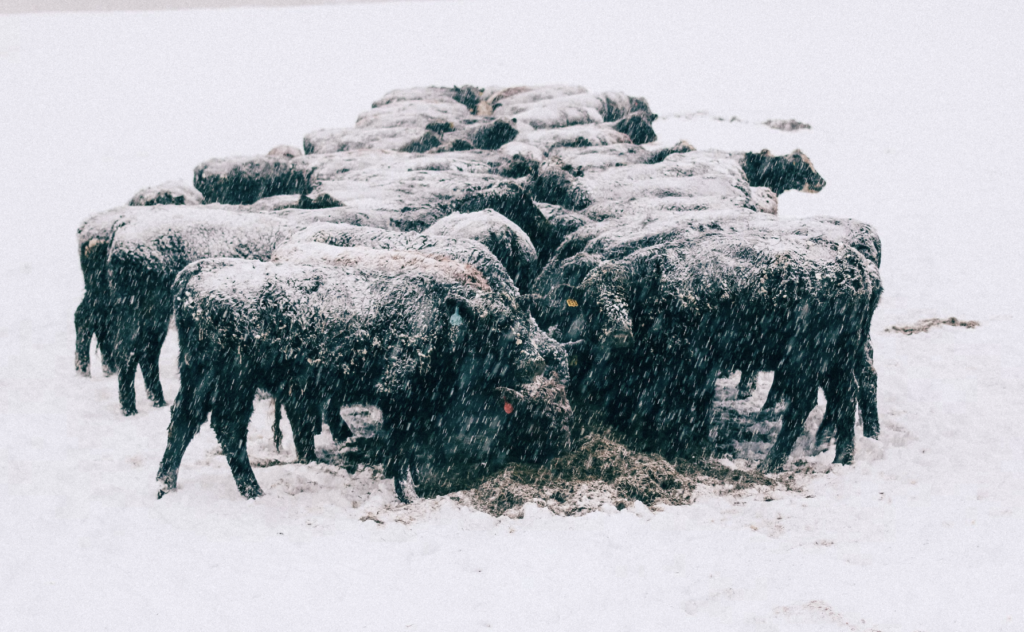One of the best ways to learn photography is by looking at examples that clearly demonstrate concepts. That is what we have tried to do in selecting these images that clearly deomstrate certain composition principles that you will become familiar with as you progress through your photography journey. The criteria for selecting the images were simple: they all had to illustrate three solid principles of photography, especially in terms composition.
“If you encounter a monkey in an absurd context,
you automatically have a very real problem in photography.”
Garry Winogrand

- Juxtaposition
Here we have a moment of juxtaposition of the train in the upper distance, symbolizing progress and the power of machines, contrasted with the vulnerability of human nature, personified by the man walking in the opposite direction of the train while carrying something, probably a painting or a mirror. Trains owe their existence to human beings, and they appear connected here by the similar tone of their coverings (i.e., the black clothes, and the black paint).
- Movement
Every subject in the frame is moving. The two principal characters here are the train itself and the humans, especially the man looking at the camera. All are moving, but the sense of speed is more obvious with the train due to the steam trail left in its wake. The people seem calm, almost static, but moving at a slow pace. The train is a symbol of progress that enabled people to travel faster than ever.
- Scale
We know that trains are huge, but here it appears tiny compared to the architecture surrounding it. The subject appears large due to the distance; in the end, the human appears larger and more like the protagonist. The train is just a beautiful and poetic background object.
Cameras belong to the world of machines, and the man’s serious look towards the camera could imply displeasure from a possible painter towards photography (but this is just a theory of mine). Trains have greatly influenced the arts, and we have spoken previously of 20 trains that inspired photography.
Garry Winogrand – New York – 1967

- Metaphor
The chimpanzees in the photograph dressed like children reflect the other child next to the couple. This is social satire, where Winogrand suggested that there is a sense of bestiality in humans and a sense of humanity in animals. Due to the two-dimensional nature of the picture, the child appears to be looking at one of the chimpanzees, when it is likely he was looking at something else outside the scene.
- Rule of Odds
It's pleasing to compose with more than one object inside the frame. When a photographer is doing this, he or she must remember that it is more aesthetic to work with simple groups of odds. Groups of 3 or 5 elements are more interesting in compositional terms than those with groups of 2 or 4 elements. The reason for this is that the human mind rushes to separate things symmetrically.
- Implied Lines
Implied lines are hard to capture because they are technically not there – they are not physical lines like vertical, horizontal, and organic lines. The couple is looking in the same direction, and the chimpanzees are peering exactly in the opposite direction. This creates a tension, but also symbolizes that they are different in nature.
The couple’s serious expression and the way the chimpanzees hold tight to them allow this image to deliver quite a punch. The image shows something that no doubt during that time caused some sort of revolt – an interracial couple – and an elegant, good-looking interracial couple to boot. New York in 1964 was the scene of several violent protests, and in 1965 Malcolm X was assassinated. In the same year that Winogrand took this picture, the US Supreme Court overturned laws prohibiting interracial marriage. The odd thing about this image is that it managed to offend both those who supported discrimination and those who tried to abolish it.
Sally Mann – Candy Cigarette – 1989

Of the three images I discuss here, this one is my favorite; it has been of my favorites for a long time. It is so intriguing that is still impossible for me to write something slightly hermeneutical, and honestly, I like it this way.
- Bye Bye, Rule of Thirds
This is an extremely vivid example of how the rule of thirds can be broken. Emmett appears diffused in the background, lonely but free. Virginia has a strong pose, like a mother or an older woman, in the right lower corner. And Jessie, holding that “candy cigarette” almost in the center of the frame, breaks all the prejudices of the thirds.
- Rule of Odds
Here we have three children: Sally Mann's three children. Her children, her whole world as a mother, split into three parts that cannot be separated in her heart and soul.
- Shallow Depth of Field
The background is shallow due to the wide lens aperture, and the tri-dimensional nature of the scene is enriched by it. Jessie gets to be the protagonist of the scene, and her strong character is enhanced by her gesture, her pose, and her sharp presence in the picture.
We hope you like these images as much as we do. This way of reading images will help you improve your photographic reading habits. Please share your thoughts, and let us know if you would like more of this kind of stuff.







5 Comments
I found it interesting that you didn’t mention the photographers shadow in the 2nd photo.. I thought it detracted from the image?!
Yes. More like this. Keep it sophisticated.
Hi… I would like to know views and critics about the DARK portion of the picture in Candy Cigarette.. My point may be a little weird but as you had mentioned in the last stanza of the article that these pictures may help all of us to read pictures but i figured out that the dark portion of the picture is distracting my mind so would like to know how you perceive or justify the same???
Regards
very interesting. I found the comments a little academic but it was good to be reminded how the couple in image 2 might have been regarded at the time
if you had not mentioned it my eyes would not have gone to the train high in the frame or the child below the monkeys.